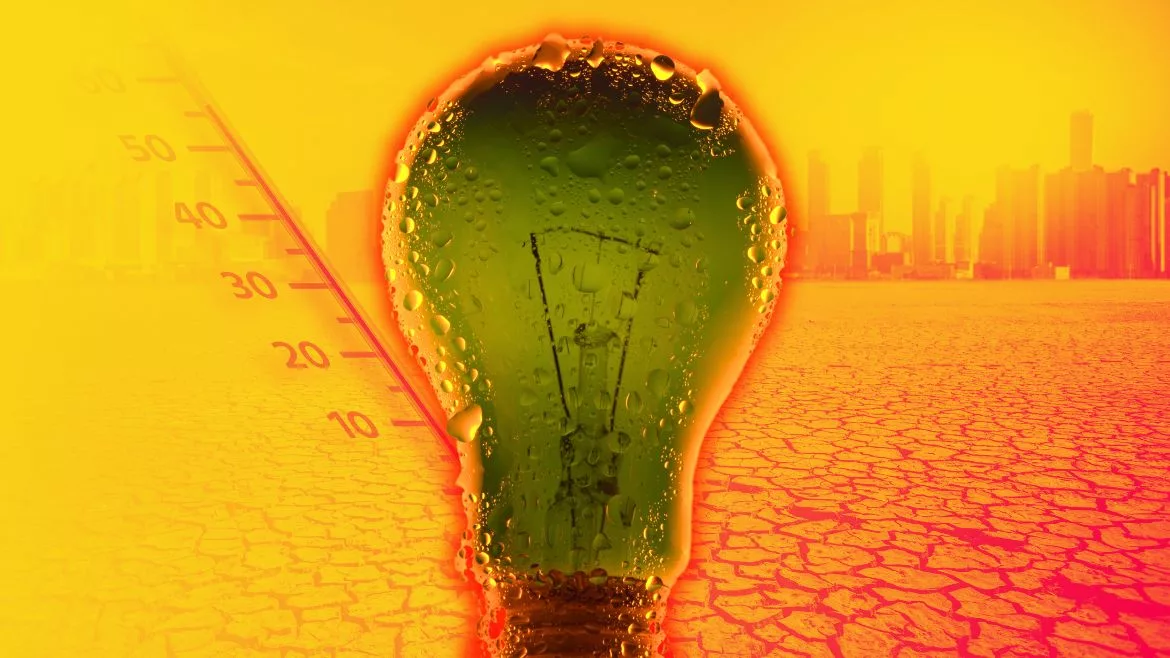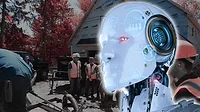The Wet-Bulb Effect: How Will Drill Operators Overcome?
With temperatures consistently on the rise, we discuss how hot is too hot for drillers

It's an unsettling thought: heat and humidity so horrendous that human life can't withstand their unsustainable nature. However, it's not the start of a captivating apocalypse novel or dystopian film—it's the mere 95° weather that many countries are >already experiencing and seeing the devastating effects of in real-time.
Now, you may be thinking to yourself, "95° is not that hot; we've had several days at that temperature in my state already this summer!" However, it's not just the temperature that concerns laborers and their companies nationwide but rather a particular set of parameters that makes this weather reach the 'wet-bulb effect' instead.
In this article, we not only take a closer look at the current state of our climate in America and beyond but also discover why the 'wet-bulb effect' is nothing to scoff at, especially in industries as taxing outdoors as the drilling and mining industries. At the end of this breakdown, hopefully, we will finally be able to definitively answer the question of 'how hot is too hot?' and prepare our teams in the field to ensure safety remains a top priority.
Things are Heating up—FAST
To truly break down the current heat and humidity risks worldwide, let's highlight just a few of the countless stories that have popped up this summer alone:
- Record Global Temperatures Present Urgent Challenges for Drillers
- OSHA Proposes Federal Heat Safety Rules to Protect Workers
- Rising Groundwater Temperatures Could Impact 75 Million by 2100
- Heat Exposure and Geothermal: Strategies for ‘Fun in the Sun’
- Map Shows Cities Set Heat Records Amid Back-to-Back Soaring Temperatures
- Heat waves are getting longer and more brutal
“Previous studies projected that this would happen several decades from now, but this shows it’s happening right now,” stated Colin Raymond, a climate scientist at NASA’s Jet Propulsion Laboratory. “The times these events last will increase and the areas they affect will grow in direct correlation with global warming.”
The research indicated a significant rise in instances of extreme humidity and heat worldwide. Between 1979 and 2017, the number of occurrences where a Wet Bulb Temperature (WBT) of 86°F was reached more than doubled. Specifically, there were around 1,000 instances of an 88°F WBT and about a dozen exceeding 95°F in regions such as Pakistan, India, Saudi Arabia, Mexico, and Australia.
A key concern is how rising temperatures due to climate change relate to increases in WBT extremes. A study from last year revealed that in the tropics, the maximum WBT will increase by 1.8°F for each 1.8°F of average global warming. Consequently, limiting global warming to 2.7°F above pre-industrial levels would prevent the majority of tropical regions—home to 40% of the global population—from hitting the critical survival threshold of 95°F.
Heatwaves are intensifying at a much faster rate than other types of extreme weather events due to the climate crisis. Scientists have determined that the climate crisis made the heatwave in India and Pakistan 30 times more likely. As another study pointed out, questioning whether today’s severe heatwaves could have happened in a pre-industrial climate is “fast becoming an obsolete question.”
In addition to all of this recent news on the subject, it's been proven that the fastest-growing cities experience the worst heat, which poses a major problem for drillers, especially in the water well and geothermal industries that grow the fastest in major cities and developing regions.
Understanding the Wet-Bulb Effect
With a better understanding of the current state of our environment and the undeniable heat increase worldwide, it's time we began to notice the most unsettling trend arising in particular countries and regions even now: the wet-bulb effect.
As Reuters explains, "High wet-bulb temperatures are dangerous because humans lose around 80% of heat through sweating, so when both humidity and air temperature are high, it becomes harder to shed excess heat. "This concept is particularly terrifying when you consider the suffocating feeling that a high-humidity heat wave can have. In essence, the wet-bulb effect occurs when the temperature and humidity increase to such a level that it is impossible for human beings to 'cool down' and heat regulate. As such, for lack of a better way to put it, the wet bulb effect 'cooks' humans from the inside out.
“The [wet-bulb] temperature reading you get will actually change depending on how humid it is,” says Kristina Dahl, a climate scientist at the Union of Concerned Scientists. “That’s the real purpose, to measure how well we’ll be able to cool ourselves by sweating.”
And it's not a week-long process or an immediate one, either. While immediate heat illness would also be terrifying, what makes this effect so disconcerting may very well be the fact that it occurs over a six-hour period, not even a full workday in the field. Working a singular day at this temperature would lead to fatality across the board, even for the fittest and heat-acclimated individuals. Think of a wet towel put over a light bulb. No matter how much the heat wants to escape, it simply cannot, and even with fans, breathable clothing, and cold water, the heat becomes too much for the human body to handle.
This temperature would only need to be 95°, approximately equivalent to an air temperature of 104° with a relative humidity of 75% for the wet-bulb effect to occur. According to Weather Underground, "Other parts of the world that are already yielding wet-bulb readings of 31°C or higher at least every three years include eastern coastal India, Pakistan, and northwestern India, and the shores of the Red Sea, Gulf of California, and the southern Gulf of Mexico." Meanwhile, Reuters states that China, India, Bangladesh, Pakistan, and Africa's Sahel region are all considered key risk zones.
And before you think we're not reaching those levels in America already, think again. The hottest heat index of 117° was just recorded in San Antonio on Tuesday, June 4, while Las Vegas saw temperatures in the 120° range and Palm Springs, California saw 124° weather this year. While the drier climates will take longer to see the humidity numbers necessary to worry, the heat and humidity are already becoming volatile in the South and other warmer climates such as Florida. In fact, according to NASA, "Within 50 years, Midwestern states like Arkansas, Missouri, and Iowa will likely hit the critical wet-bulb temperature limit."
The outcome of all of this? Our climate will eventually become inhospitable for outdoor labor in the summer, which could greatly affect boots-on-the-ground workers and the careers they have built for themselves. If not taken seriously, we could very well see an increase in heat-related injuries and deaths simply based on a lack of heat safety protocols.
What's Next? Protecting Boots-on-the-Ground Drillers
While it's a topic we at The Driller cover often in The Driller Newscast and various articles, the imperative nature of heat safety protocols on the job site is one that must be impressed regularly and vehemently throughout the summer and beyond. It's not just about personal comfort and safety but rather the safety of your entire team. Especially when it comes to younger individuals on worksites looking to earn favor, ego can become a deadly decision. Everyone thinks they're fine until they are not. Knowing this, as we inch ever closer to the wet-bulb effect in major cities in America, it's crucial that we follow the heat safety guidelines set forth by OSHA and encouraged by industry leaders such as our very own Industry Editor, Brock Yordy:
- Drink at least 32 ounces of water on a hot workday
- Replenish electrolytes using hydration multipliers and salty snacks
- Seek shade
- Rest often
- Wear UPF, breathable clothing
- Track the heat index and humidity levels
- Appoint heat accountability pairs so everyone is accounted for
- NEVER put a project over the safety of your team
In addition to these protocols, Gordon Giesbrecht, a professor of thermophysiology at the University of Manitoba, shared a few insights specifically related to the wet bulb effect. For instance, Giesbrecht warned not to assume fans will help when this effect is occurring: "Fans only help if the air temperature is cooler than your 33 C skin temperature; if the air is warmer, the fan will only warm your skin more."
Furthermore, Giesbrecht encourages boots-on-the-ground workers to wet their shirts with cold water rather than taking them off in extreme humidity, "The water in the shirt will evaporate and cool the skin off. If you don't have a shirt on any part of their skin, that water will just roll off onto the ground. I'll take a liter [of water] and pour it on this person and wait till it starts to dry out, and then I'll put some more on them so I can keep using that cooling effect of evaporation."
Equipped with these guidelines, drillers may be able to withstand this heat for decades to come, but from an environmental perspective, it's time we begin to take a closer look at how we can repair our climate's damage and cool down our world once more.
Geothermal projects, water rights, and environmental efforts all help to eliminate climate harm. Still, for a true change to be made for the future of hardworking individuals worldwide, we must be willing to go above and beyond and consider how our laws and creature comforts affect our world year after year.
Looking for a reprint of this article?
From high-res PDFs to custom plaques, order your copy today!




